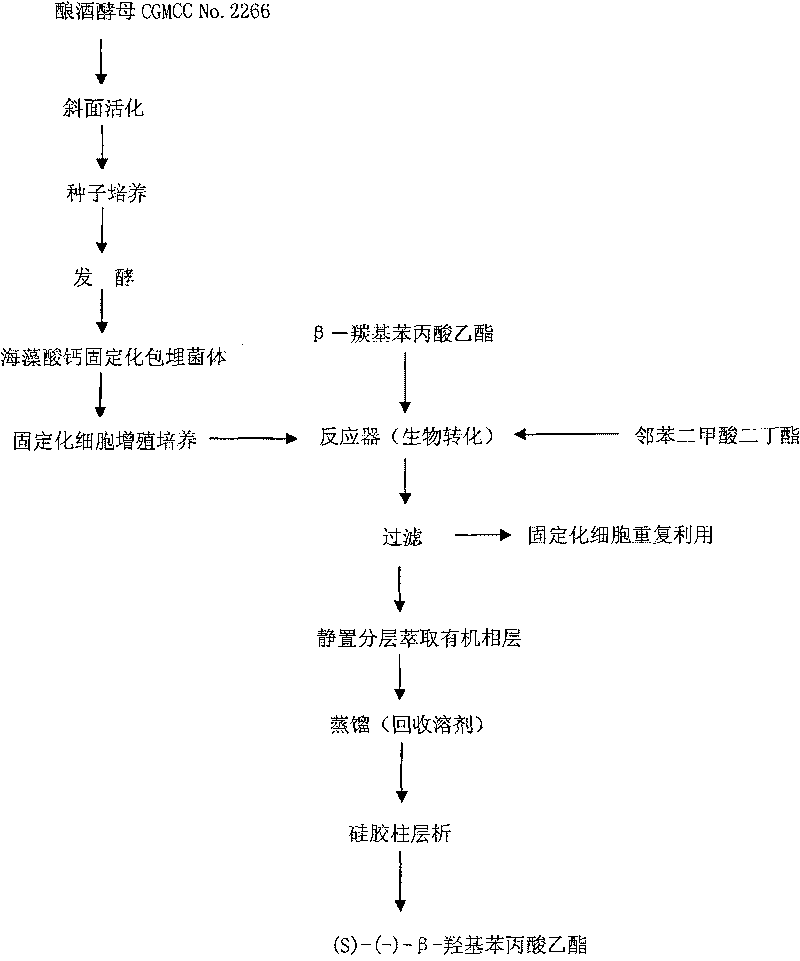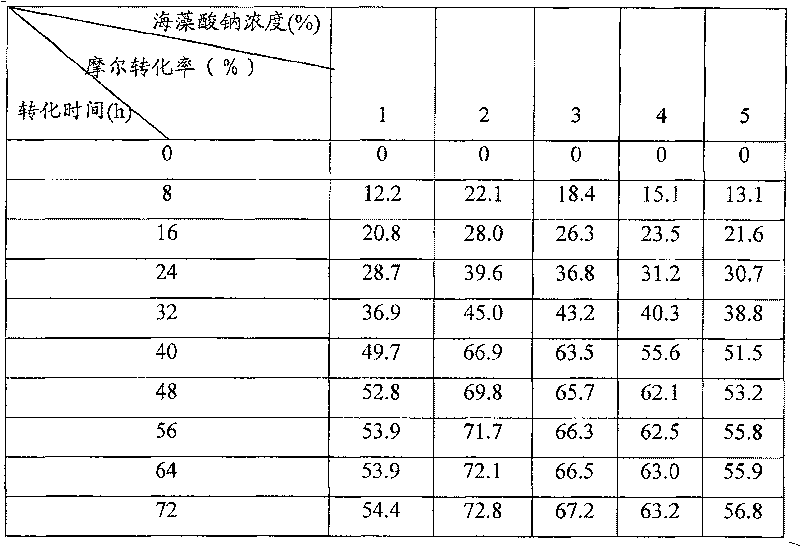Saccharomyces cerevisiae CGMCC No.2266 and its application in preparation of (S)-(-)- beta-hydroxyphenyl propionic acid ethyl
A technology of ethyl carbonyl phenylpropionate, cgmccno.2266, applied in Saccharomyces cerevisiae CGMCC No.2266 and its application field in the preparation of (S)-(-)-beta-hydroxyphenylpropionate ethyl ester, can solve the problem of Low biotransformation production capacity, unbearable cell catalysis, cytotoxicity and other problems, to achieve the effect of easy large-scale industrial production, environmental friendliness and low cost
- Summary
- Abstract
- Description
- Claims
- Application Information
AI Technical Summary
Problems solved by technology
Method used
Image
Examples
Embodiment 1
[0040] Process flow chart see figure 1 .
[0041] Incline cultivation:
[0042] Inoculate CGMCC No.2266 bacteria into the slant culture medium and culture at 30°C for 4-6 days to obtain the slant bacteria. Slant medium preparation: 10g of wort juice, 3g of yeast powder, 5g of peptone, 10g of glucose, 20g of agar, 1000g of water, natural pH, sterilized at 121°C for 20 minutes, cooled to make a slope.
[0043] Seed culture and fermentation culture:
[0044] Both the seeds and the fermentation medium are liquid medium, prepared according to the following composition: glucose 30g, yeast powder 3g, ammonium sulfate 5g, anhydrous MgSO 4 0.25g, K 2 HPO 4 ·3H 2 O 1g, KH 2 PO 4 1g, 1000g water, natural pH, sterilized at 121°C for 20 minutes, cooled for later use. Use an inoculation needle to take a ring of slant bacteria from the slant medium and inoculate it into a 250ml Erlenmeyer flask containing 100ml of liquid medium, and culture it at 30°C and 180r / min for 24 hours to ...
Embodiment 2
[0050] CGMCC No.2266 was cultivated according to the method in Example 1 to obtain bacterial cell fermentation broth. 4 bottles of 100ml fermented broth with a dry weight of 430mg were mixed with 100ml of sodium alginate solution with a concentration of 2% (w / w%) to make a mixed solution, and the mixed solution was respectively packed into syringes with different needle sizes. Add 3.5% (w / w%) CaCl dropwise 2 Immobilized particles were formed in the solution, and the diameters of the formed particles were 2mm, 3mm, 4mm and 5mm respectively. They were solidified at 37°C for 30 minutes, and the obtained immobilized particles were washed with sterile physiological saline to remove excess calcium ions and untreated particles. For the captured cells, the obtained immobilized cell particles were continued to proliferate and culture in liquid medium for 24 hours.
[0051] Add the above-mentioned 4 kinds of immobilized cell particles that have been proliferated and cultured into 300ml...
Embodiment 3
[0055] CGMCC No.2266 was cultivated according to the method in Example 1 to obtain bacterial cell fermentation broth. Mix 100ml of 4 bottles of fermented liquid with a dry weight of 430mg of bacteria and 100ml of sodium alginate solution with a concentration of 2% (w / w%) to make a mixed solution, put the mixed solution into a syringe respectively, and drop in 3.5% (w / w%)CaCl 2 Form immobilized particles in the solution, the diameter of the formed immobilized particles is 2mm, solidify at 37°C for 30min, and the obtained immobilized particles are washed with sterile physiological saline to remove excess calcium ions and uncaptured cells, and the obtained 4 The bottle-immobilized cell particles continued to proliferate and culture in liquid medium for 0h, 24h, 48h and 72h respectively.
[0056] Add the above-mentioned 4 kinds of immobilized cell particles proliferated and cultured into 300ml dibutyl phthalate containing 15.45mmol ethyl β-carbonylphenylpropionate, and carry out ...
PUM
| Property | Measurement | Unit |
|---|---|---|
| particle diameter | aaaaa | aaaaa |
| diameter | aaaaa | aaaaa |
| diameter | aaaaa | aaaaa |
Abstract
Description
Claims
Application Information
 Login to View More
Login to View More - R&D
- Intellectual Property
- Life Sciences
- Materials
- Tech Scout
- Unparalleled Data Quality
- Higher Quality Content
- 60% Fewer Hallucinations
Browse by: Latest US Patents, China's latest patents, Technical Efficacy Thesaurus, Application Domain, Technology Topic, Popular Technical Reports.
© 2025 PatSnap. All rights reserved.Legal|Privacy policy|Modern Slavery Act Transparency Statement|Sitemap|About US| Contact US: help@patsnap.com



